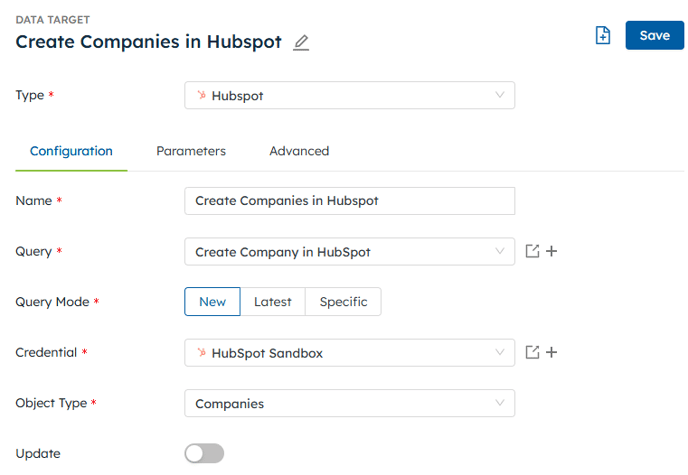Companies - HubSpot Data Target Requirement
This guide explains how to configure a Data Target in DataBlend to create or update Company records in HubSpot. It includes use cases, detailed steps, and troubleshooting tips to help you complete the setup process with ease.
Table of Contents
Steps to Set Up the Data Target
Step 2: Configure the Data Target in DataBlend
Step 3: Test and Run the Data Target
Use Cases
Creating and updating Companies in HubSpot using DataBlend allows you to integrate data across systems to manage customers, vendors, and financial workflows effectively. Below are some common use cases:
- CRM System Integration: Sync company records between HubSpot and ERP/accounting software for consistency in financial and CRM data.
- Vendor and Partner Syncing: Create or update vendor and partner records in HubSpot with key financial details like outstanding balances or payment terms.
- Financial Data Updates: Automate updates to company records with financial details like revenue, payment status, or credit limits from your ERP/accounting systems.
Steps to Set Up the Data Target
Step 1: Prepare Your Data
To ensure successful integration your data should match HubSpot’s required and optional fields.
Required fields. You need at least one of the following fields to create a Company:
name(the company’s name)domain(the company’s website domain).
Tip: It’s strongly recommended to include domain as it serves as a unique identifier in HubSpot, preventing duplicate companies from being created.
Other fields are optional. Use the format below as a reference.
Tip: To see all the available fields in your HubSpot instance, set up a HubSpot Collector in DataBlend to pull records from the Company object and review the list of fields.|
HubSpot Fields (API) |
Required |
Example |
Notes |
|---|---|---|---|
| name | Yes, if domain is not included |
Smith Co | Required unless domain is provided. |
| domain | Yes, if name is not included |
smith.com | Strongly recommended to avoid duplicates. |
| industry | Optional | Software | Useful for segmentation |
| phone | Optional | +1-987-654-3210 | Include the country code |
| website | Optional | https://www.smith.com | Format as a valid URL. |
Step 2: Configure the Data Target in DataBlend
- Navigate to the Data Targets section in the main left-hand side Menu.
- Click + Add to create a new Data Target.
- Configure the following fields:
| Field Name | Value |
| Type | Select HubSpot from the dropdown menu. |
| Name | Enter a descriptive name to your Data Target (e.g., "Create Companies in HubSpot"). |
| Query | Select a query from the dropdown list that you've prepared to create Companies in HubSpot. |
| Query Mode |
New: to run the query within the Data Target. Specific: to send data from a specific query execution based on a chosen timestamp |
| Credential | Select the credential for the HubSpot instance where data will be sent. |
| Object Type | Select Companies |
| Update | Off: to create new Companies, On: to update existing Companies |
Example Configuration:

Step 3: Test and Run the Data Target
1. Run the Data Target: Click Run Data Target in DataBlend to send test data to HubSpot. It's recommended to test with a single record first. To do this, set the limit to 1 in the query configuration.
- If the test is successful, proceed to send all records.
- If the test execution returns errors or warnings, navigate to the latest execution log to review the details.

Troubleshooting
If you encounter any issues, use the following tips to diagnose and resolve them:
- Authentication Errors: Verify the connection to HubSpot is Valid and associated with the correct HubSpot account. Ensure that the credential permissions allow access to the Companies object.
- Field Mapping Issues: Double-check that all required fields (
nameordomain) are included and correctly formatted. Confirm that optional fields meet HubSpot’s formatting requirements (e.g., URLs must start withhttps://). - Data Import Errors: Review the logs in DataBlend for specific error messages. Common error codes and solutions:
| Error | Description | Solution |
| 400 (Bad Request) | Missing required fields or incorrect field values. | Ensure name or domain is included and valid. |
| 401 (Unauthorized) | Invalid API key or OAuth token. | Reauthenticate with a valid credential. |
| 422 (Unprocessable Entity) | The data provided is invalid or incomplete. | Verify that all fields are correctly formatted. |
| One or more errors occurred | Process encountered one or more issues during execution | If the issue persists and you cannot identify the root cause, contact DataBlend support with the errored execution link. |
Additional Resources
- Data Target Basics: An overview of Data Targets in DataBlend
- HubSpot API Documentation - Companies: Learn more about HubSpot’s Companies object and available fields.
- How to set up a HubSpot connection in DataBlend: Detailed instructions for creating and testing HubSpot credentials in DataBlend.
